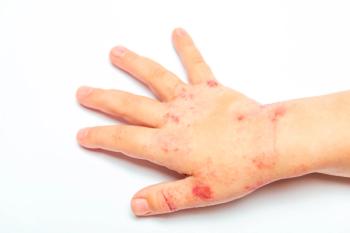
- Consultant for Pediatricians Vol 7 No 1
- Volume 7
- Issue 1
Pityriasis Lichenoides Et Varioliformis Acuta in a 10-Year-Old Boy
A 10-year-old boy presented with a persistent rash that began several months earlier as recurrent crops of papules and a few vesicles with crusting. Varicella was initially diagnosed, and the patient was treated unsuccessfully with over-the-counter drying lotions. The patient denied systemic symptoms and pruritus and was in his usual state of health otherwise. Review of systems, family history, and social history were unremarkable. There was no history of travel or new exposures during this period.
A 10-year-old boy presented with a persistent rash that began several months earlier as recurrent crops of papules and a few vesicles with crusting. Varicella was initially diagnosed, and the patient was treated unsuccessfully with over-the-counter drying lotions. The patient denied systemic symptoms and pruritus and was in his usual state of health otherwise. Review of systems, family history, and social history were unremarkable. There was no history of travel or new exposures during this period.
Numerous scattered, mildly erythematous, brownish papules were scattered over the trunk, upper ex- tremities, buttocks, and upper thighs. Many were slightly scaly and several had developed an eschar. The patient also had multiple areas of postinflammatory hyperpigmentation and a few varioliform scars. Other examination findings were normal.
The patient was referred to a dermatologist who confirmed the diagnosis of pityriasis lichenoides et varioliformis acuta (PLEVA).
PLEVA (also known as Mucha-Habermann disease) is a rare skin condition of unknown origin. Although most common in young adults, PLEVA can affect any age group, including children.1 PLEVA and pityriasis lichenoides chronica are at opposite ends of the same spectrum; the terms "acute" and "chronic" refer to the timeline of the individual lesions rather than the clinical course.1,2 The disease is characterized by insidious onset and a lack of symptoms other than mild pruritus and low-grade fever. Males are more commonly affected than females. There is no geographical or racial predisposition.1,2
Pityriasis lichenoides is often described as a papulosquamous disorder based on its appearance; however, the predominance of CD8+ T cells in biopsy specimens suggests that it may be a lymphoproliferative disorder.3 Although commonly considered benign, malignant transformation with progression to cutaneous T-cell lymphoma has been reported.4,5 "Epidemic" outbreaks during the fall and winter and onset or flaring of the disease after infections provide further support of an immune-mediated hypersensitivity against an infectious agent.2 PLEVA is associated with infection with HIV, Epstein-Barr virus, Cytomegalovirus, Parvovirus, group A b-hemolytic Streptococcus, and Staphylococcus aureus.2,4
The rash consists of reddish brown, round to oval papules of 2 to 10 mm that appear in crops either singly or in clusters. A violaceous center may develop with micaceous scale. The lesions can become vesicular or pustular, may undergo hemorrhagic necrosis, and frequently result in postinflammatory hyperpigmentation (or less commonly varioloid scarring). The rash most commonly involves the trunk, thighs, and upper arms; the face, scalp, and palms/soles are involved in about 10% of cases.1,2,4
Febrile ulceronecrotic Mucha-Habermann disease (a severe subtype of PLEVA, characterized by a more destructive rash with fever and systemic involvement) is associated with up to 25% mortality.4 The differential diagnosis includes insect bites, varicella, viral exanthema, Gianotti-Crosti syndrome, psoriasis guttata, lymphomatoid papulosis, and secondary syphilis.2,4 This variant is a medical emergency. Systemic corticosteroid therapy is the treatment of choice.
In many patients with PLEVA, first-line therapy with erythromycin estolate or ethylsuccinate (30 to 50 mg/kg divided in 3 equal doses daily) for up to 8 weeks can result in remission; tapering over several months is necessary to prevent recurrence.4,6 Topical corticosteroids and oral antihistamines may provide symptomatic relief but have no real effect on the disease course. Other variably effective therapies include psoralen plus UV-A, UV-B phototherapy, tetracycline, gold, methotrexate, oral corticosteroids, and dapsone.1,2,4 When first-line therapies fail, UV light therapy can be used. Systemic immunosuppressant therapy is reserved for more severe cases. With any of these treatments, PLEVA can persist for months, even years, and relapse is common.
Therapy with erythromycin initially controlled this patient's rash; however, his symptoms eventually recurred despite an extended taper. He is currently receiving UV-B therapy and has had no further recurrence. *
The opinions contained herein are those of the author and should not be construed as official or as reflecting the views of the US Air Force or the Department of Defense.
References:
REFERENCES:
1.
Habif TP.
Clinical Dermatology: A Color Guide to Diagnosis and Therapy.
4th ed. St Louis: Mosby; 2004:261.
2.
Ersoy-Evans S, Greco MF, Mancini AJ, et al. Pityriasis lichenoides in childhood: a retrospective review of 124 patients.
J Am Acad Dermatol.
2007; 56:205-210.
3.
Magro C, Crowson AN, Kovatich A, Burns F. Pityriasis lichenoides: a clonal T-cell lymphoproliferative disorder.
Hum Pathol.
2002;33:788-795.
4.
Bowers S, Warshaw EM. Pityriasis lichenoides and its subtypes.
J Am Acad Dermatol.
2006;55:557-572.
5.
Fortson JS, Schroeter AL, Esterly NB. Cutaneous T-cell lymphoma (parapsoriasis en plaque). An association with pityriasis lichenoides et varioliformis acuta in young children.
Arch Dermatol.
1990;126: 1449-1453.
6.
Truhan AP, Hebert AA, Esterly NB. Pityriasis lichenoides in children: therapeutic response to erythromycin.
J Am Acad Dermatol.
1986;15:66-70.
Articles in this issue
almost 18 years ago
Left-Sided Appendicitis in an 11-Year-Old Girlalmost 18 years ago
Welcome to Our New Editorial Board Member, Dr Linda Nieldalmost 18 years ago
Peanut Allergy: Earlier Exposure--Earlier Reactionsalmost 18 years ago
Radiographic Findings in Cystic Fibrosisalmost 18 years ago
Trachyonychia in a School-Aged Girlalmost 18 years ago
Streptococcus Intertrigoabout 18 years ago
Strabismus: REFERENCES:Newsletter
Access practical, evidence-based guidance to support better care for our youngest patients. Join our email list for the latest clinical updates.








